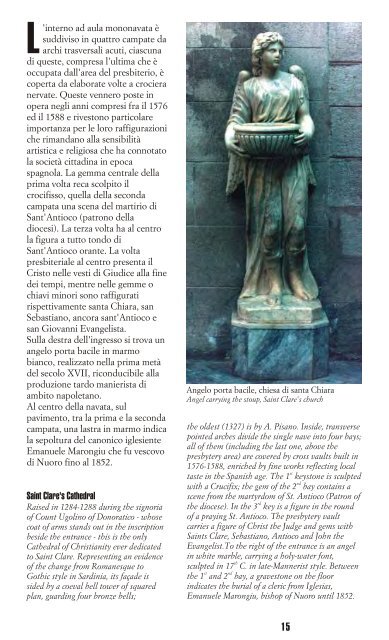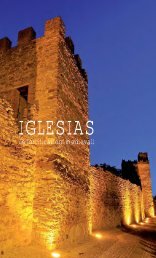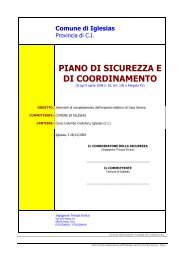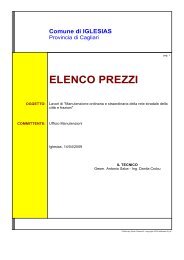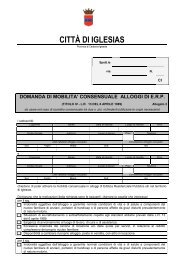Architetture religiose e arte sacra - Comune di Iglesias
Architetture religiose e arte sacra - Comune di Iglesias
Architetture religiose e arte sacra - Comune di Iglesias
Create successful ePaper yourself
Turn your PDF publications into a flip-book with our unique Google optimized e-Paper software.
'interno ad aula mononavata è<br />
sud<strong>di</strong>viso in quattro campate da<br />
L<strong>di</strong><br />
archi trasversali acuti, ciascuna<br />
queste, compresa l'ultima che è<br />
occupata dall'area del presbiterio, è<br />
coperta da elaborate volte a crociera<br />
nervate. Queste vennero poste in<br />
opera negli anni compresi fra il 1576<br />
ed il 1588 e rivestono particolare<br />
importanza per le loro raffigurazioni<br />
che rimandano alla sensibilità<br />
artistica e religiosa che ha connotato<br />
la società citta<strong>di</strong>na in epoca<br />
spagnola. La gemma centrale della<br />
prima volta reca scolpito il<br />
crocifisso, quella della seconda<br />
campata una scena del martirio <strong>di</strong><br />
Sant'Antioco (patrono della<br />
<strong>di</strong>ocesi). La terza volta ha al centro<br />
la figura a tutto tondo <strong>di</strong><br />
Sant'Antioco orante. La volta<br />
presbiteriale al centro presenta il<br />
Cristo nelle vesti <strong>di</strong> Giu<strong>di</strong>ce alla fine<br />
dei tempi, mentre nelle gemme o<br />
chiavi minori sono raffigurati<br />
rispettivamente santa Chiara, san<br />
Sebastiano, ancora sant'Antioco e<br />
san Giovanni Evangelista.<br />
Sulla destra dell'ingresso si trova un<br />
angelo porta bacile in marmo<br />
bianco, realizzato nella prima metà<br />
del secolo XVII, riconducibile alla<br />
produzione tardo manierista <strong>di</strong><br />
ambito napoletano.<br />
Al centro della navata, sul<br />
pavimento, tra la prima e la seconda<br />
campata, una lastra in marmo in<strong>di</strong>ca<br />
la sepoltura del canonico iglesiente<br />
Emanuele Marongiu che fu vescovo<br />
<strong>di</strong> Nuoro fino al 1852.<br />
Saint Clare's Cathedral<br />
Raised in 1284-1288 during the signoria<br />
of Count Ugolino of Donoratico - whose<br />
coat of arms stands out in the inscription<br />
beside the entrance - this is the only<br />
Cathedral of Christianity ever de<strong>di</strong>cated<br />
to Saint Clare. Representing an evidence<br />
of the change from Romanesque to<br />
Gothic style in Sar<strong>di</strong>nia, its façade is<br />
sided by a coeval bell tower of squared<br />
plan, guar<strong>di</strong>ng four bronze bells;<br />
Angelo porta bacile, chiesa <strong>di</strong> santa Chiara<br />
Angel carrying the stoup, Saint Clare's church<br />
the oldest (1327) is by A. Pisano. Inside, transverse<br />
pointed arches <strong>di</strong>vide the single nave into four bays;<br />
all of them (inclu<strong>di</strong>ng the last one, above the<br />
presbytery area) are covered by cross vaults built in<br />
1576-1588, enriched by fine works reflecting local<br />
st<br />
taste in the Spanish age. The 1 keystone is sculpted<br />
nd<br />
with a Crucifix; the gem of the 2 bay contains a<br />
scene from the martyrdom of St. Antioco (Patron of<br />
rd<br />
the <strong>di</strong>ocese). In the 3 key is a figure in the round<br />
of a praying St. Antioco. The presbytery vault<br />
carries a figure of Christ the Judge and gems with<br />
Saints Clare, Sebastiano, Antioco and John the<br />
Evangelist.To the right of the entrance is an angel<br />
in white marble, carrying a holy-water font,<br />
th<br />
sculpted in 17 C. in late-Mannerist style. Between<br />
st nd<br />
the 1 and 2 bay, a gravestone on the floor<br />
in<strong>di</strong>cates the burial of a cleric from <strong>Iglesias</strong>,<br />
Emanuele Marongiu, bishop of Nuoro until 1852.<br />
15


